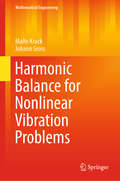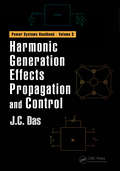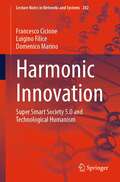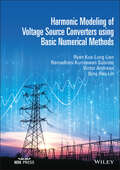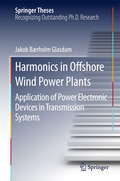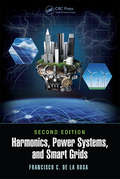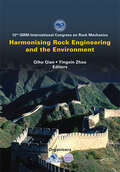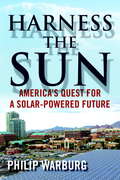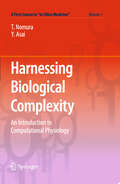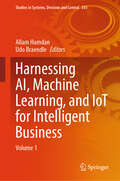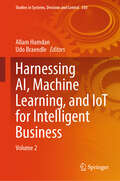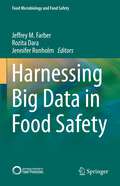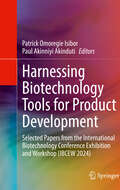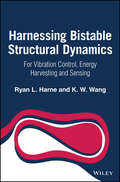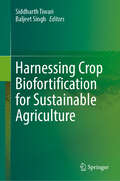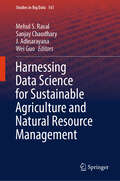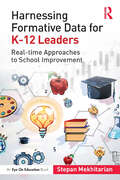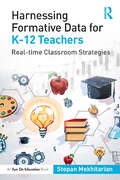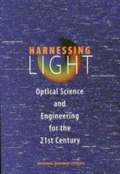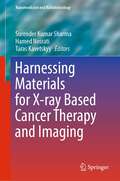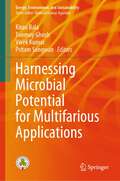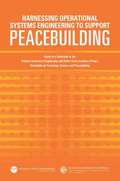- Table View
- List View
Harmonic Balance for Nonlinear Vibration Problems (Mathematical Engineering)
by Malte Krack Johann GrossThis monograph presents an introduction to Harmonic Balance for nonlinear vibration problems, covering the theoretical basis, its application to mechanical systems, and its computational implementation. Harmonic Balance is an approximation method for the computation of periodic solutions of nonlinear ordinary and differential-algebraic equations. It outperforms numerical forward integration in terms of computational efficiency often by several orders of magnitude. The method is widely used in the analysis of nonlinear systems, including structures, fluids and electric circuits. The book includes solved exercises which illustrate the advantages of Harmonic Balance over alternative methods as well as its limitations. The target audience primarily comprises graduate and post-graduate students, but the book may also be beneficial for research experts and practitioners in industry.
Harmonic Generation Effects Propagation and Control
by J. C. DasThis book provides coverage of generation, effects, and control of harmonics, including interharmonics and measurements, measurements and estimation of harmonics, harmonic resonance and limitations, according to standards. It serves as a practical guide to undergraduate and graduate students, as well as practicing engineers on harmonics. The concepts of modeling filter designs and harmonic penetrations (propagations) in industrial systems, distribution, and transmission systems are amply covered with the application of SVCs and FACTS controllers. Harmonic analysis in wind and solar generating plants are also discussed. Many case studies and practical examples are included to emphasize real-world applications. The appendices are devoted to Fourier analysis, pertinent to harmonic analysis, and solutions to the problems included throughout the book.
Harmonic Innovation: Super Smart Society 5.0 and Technological Humanism (Lecture Notes in Networks and Systems #282)
by Domenico Marino Francesco Cicione Luigino FiliceThis book is aimed at researchers, entrepreneurs, and innovation consultants of the 5.0 era. For many centuries, the dominant paradigm of innovation was based on competition and the protection of the achievements (closed innovation).In the early years of the new millennium, the advent of globalization and the network has made the model evolve towards open and collaborative approaches (open innovation).Both methods corresponded to a different view of the world and society.Today, in a historical phase in which the world needs to become more sustainable and equitable, from the heart of the Mediterranean, the cradle of classical civilization, a group of valuable academics, scholars, and entrepreneurs propose to the world a new and further evolution of the concept of innovation and expression of the era we are living in: the harmonic innovation, an attempt to combine science and wisdom, technique and spirit, scientific research and moral research, technological progress and new humanism, new economy and social impacts, power, and limit.Anybody who aims to discover a fragment of future is welcome to read this book.
Harmonic Modeling of Voltage Source Converters using Basic Numerical Methods (IEEE Press)
by Ryan Kuo-Lung Lian Ramadhani Kurniawan Subroto Victor Andrean Bing Hao LinHarmonic Modeling of Voltage Source Converters using Basic Numerical Methods One of the first books to bridge the gap between frequency domain and time-domain methods of steady-state modeling of power electronic converters Harmonic Modeling of Voltage Source Converters using Basic Numerical Methods presents detailed coverage of steady-state modeling of power electronic devices (PEDs). This authoritative resource describes both large-signal and small-signal modeling of power converters and how some of the simple and commonly used numerical methods can be applied for harmonic analysis and modeling of power converter systems. The book covers a variety of power converters including DC-DC converters, diode bridge rectifiers (AC-DC), and voltage source converters (DC-AC). The authors provide in-depth guidance on modeling and simulating power converter systems. Detailed chapters contain relevant theory, practical examples, clear illustrations, sample Python and MATLAB codes, and validation enabling readers to build their own harmonic models for various PEDs and integrate them with existing power flow programs such as OpenDss. This book: Presents comprehensive large-signal and small-signal harmonic modeling of voltage source converters with various topologies Describes how to use accurate steady-state models of PEDs to predict how device harmonics will interact with the rest of the power system Explains the definitions of harmonics, power quality indices, and steady-state analysis of power systems Covers generalized steady-state modeling techniques, and accelerated methods for closed-loop converters Shows how the presented models can be combined with neural networks for power system parameter estimations Harmonic Modeling of Voltage Source Converters using Basic Numerical Methods is an indispensable reference and guide for researchers and graduate students involved in power quality and harmonic analysis, power engineers working in the field of harmonic power flow, developers of power simulation software, and academics and power industry professionals wanting to learn about harmonic modeling on power converters.
Harmonics in Offshore Wind Power Plants
by Jakob Bærholm GlasdamThisbook reports on cutting-edge findings regarding harmonic stability assessmentfor offshore wind power plants (OWPPs). It presents a timely investigation ofthe harmonic stability interaction between OWPPs on the one hand, andassociated control systems in the wind turbines and other power electronicdevices in the transmission system on the other. The book particularly focuseson voltage-sourced converter high-voltage direct current (VSC-HVDC) and staticcompensator (STATCOM) systems. From a practical perspective, the book reportson appropriate models for power electronic devices. It describes how thefrequency domain evaluation approach can be assessed by comparing resultsobtained with the Nyquist stability criterion against the more detailed electromagnetictransient based model realized in the PSCAD/EMTDC simulation program. The bookalso provides a concise yet complete overview of large OWPPs that incorporatepower electronic devices on a broad scale, and highlights selected challengesand opportunities in the context of real-world applications.
Harmonics, Power Systems, and Smart Grids
by Francisco C. De La RosaHarmonics, Power Systems, and Smart Grids, Second Edition compiles the most relevant aspects of harmonics in a way that the unfamiliar reader can better grasp the subject matter and the experienced reader can directly access specific subjects of interest. The text begins with a definition of harmonics, along with analytical expressions for electrical parameters under nonsinusoidal situations, and then: <P><P> Discusses important and widely used industry standards to control harmonic distortion levels Describes methods to mitigate the effects of harmonics, detailing the operation principles and design of passive filters and active filter fundamentals Presents alternative methods, such as stiffer AC sources, power converters with increased number of pulses, series reactors, and load reconfiguration Reviews the elements that play a role in the study of the propagation of harmonic currents in a distribution network Explains how to determine power losses in electrical equipment attributed to harmonic waveform distortion Covers harmonics from solar and wind power converters and power electronics in FACTS and HVDC technologies Explores harmonics from electric vehicles connected to the grid, superconductive fault current limiters, and electric vehicle charging stations Featuring three new chapters, a number of new examples and figures, and updates throughout, Harmonics, Power Systems, and Smart Grids, Second Edition provides a comprehensive reference on harmonic current generation, propagation, and control in electrical power networks, including the broadly cited smart grid.
Harmonising Rock Engineering and the Environment
by Yingxin Zhou Qihu QianHarmonising Rock Mechanics and the Environment comprises the proceedings (invited and contributed papers) of the 12th ISRM International Congress on Rock Mechanics (Beijing, China, 18-21 October 2011). The contributions cover the entire scope of rock mechanics and rock engineering, with an emphasis on the critical role of both disciplines in sustai
Harness the Sun
by Philip WarburgGoing from the inner city to the open desert, a seasoned environmental advocate looks at solar energy's remarkable ascent and its promise for America's future Solar power was once the domain of futurists and environmentally minded suburbanites. Today it is part of mainstream America. Scan the skyline of downtown neighborhoods, check out the rooftop of the nearest Walmart, and take a close look at your local sports arena. Chances are you'll find solar panels in those and many other unexpected places. In Harness the Sun, Philip Warburg takes readers on a far-flung journey that explores America's solar revolution. Beginning with his solar-powered home in New England, he introduces readers to the pioneers who are spearheading our move toward a clean energy economy. We meet the CEOs who are propelling solar power to prominence and the intrepid construction workers who scale our rooftops installing panels. We encounter the engineers who are building giant utility-scale projects in prime solar states like Nevada, Arizona, and California, and the biologists who make sure wildlife is protected at those sites. Warburg shows how solar energy has won surprising support across the political spectrum. Prominent conservatives embrace solar power as an emblem of market freedom, while environmental advocates see it as a way to reduce America's greenhouse gas emissions. At the same time, economic-justice activists celebrate solar's potential to lift up low-income communities, and Native American leaders welcome the income and jobs that the industry will bring to their communities. Yet solar energy has its downsides and detractors too. Conservationists worry about the impact of large solar farms on protected animal species, and some local citizens groups resent the encroachment of solar projects on farmland and open spaces. Warburg gives voice to those at the epicenter of these conflicts and points the way to constructive solutions. Harness the Sun offers a grounded, persuasive vision of America's energy future. It is a future fueled by clean, renewable sources of power, with solar at center stage.
Harnessing Biological Complexity
by Masao Tanaka Taishin Nomura Yoshiyuki AsaiThe challenge for the biosciences in the twenty-first century is to integrate genome sequencing information into a better understanding of biology, physiology, and human pathology. Such attempts at integration are moving the world toward a new generation of bioscience and bioengineering, where biological, physiological, and pathological information from humans and other living animals can be quantitatively described in silico across multiple scales of time and size and through diverse hierarchies of organization -- from molecules to cells and organs, to individuals. To "harness" such complexity, international communities of integrative bioscientists and bioengineers aim to establish frameworks and information infrastructures for describing biological structures and physiological functions on multiple scales of time and space. This textbook includes a public platform to describe physiological functions using mathematical equations and guides the reader to perform mathematical modeling and computer simulations, to combine existing models as well as to create new models. Accessible to biologists, physiologists, and students of the sciences, with illustrative details provided when necessary, this book seeks to achieve a systematic way of harnessing biological complexity. Sharing the databases among communities worldwide will help to find comprehensive answers to all the important questions.
Harnessing AI, Machine Learning, and IoT for Intelligent Business: Volume 1 (Studies in Systems, Decision and Control #555)
by Allam Hamdan Udo BraendleThis book is a comprehensive guide that explores the integration of artificial intelligence (AI), machine learning (ML), and the Internet of Things (IoT) in the realm of business management and finance. The convergence of AI, ML, and IoT has revolutionized various industries, and business management and finance are no exceptions. This book addresses the growing need for understanding the practical implications of these technologies in the context of financial management. It equips both academics and industry professionals with the knowledge and tools necessary to navigate the changing landscape and effectively harness these technologies to gain a competitive edge. This book delves into the transformative potential of these technologies and provides valuable insights into their application in decision-making, risk management, financial analysis, and strategic planning. It offers a holistic perspective on how organizations can leverage AI, ML, and IoT to drive innovation, enhance operational efficiency, and achieve sustainable growth in the digital age.
Harnessing AI, Machine Learning, and IoT for Intelligent Business: Volume 2 (Studies in Systems, Decision and Control #550)
by Allam Hamdan Udo BraendleThis book addresses the growing need for understanding the practical implications of these technologies in the context of financial management. The convergence of AI, ML, and IoT has revolutionized various industries, and business management and finance are no exceptions. This book equips both academics and industry professionals with the knowledge and tools necessary to navigate the changing landscape and effectively harness these technologies to gain a competitive edge. "Intelligent Business" is a comprehensive guide that explores the integration of artificial intelligence (AI), machine learning (ML), and the Internet of Things (IoT) in the realm of business management and finance. This book delves into the transformative potential of these technologies and provides valuable insights into their application in decision-making, risk management, financial analysis, and strategic planning. It offers a holistic perspective on how organizations can leverage AI, ML, and IoT to drive innovation, enhance operational efficiency, and achieve sustainable growth in the digital age.
Harnessing Big Data in Food Safety (Food Microbiology and Food Safety)
by Jeffrey M. Farber Rozita Dara Jennifer RonholmBig Data technologies have the potential to revolutionize the agriculture sector, in particular food safety and quality practices. This book is designed to provide a foundational understanding of various applications of Big Data in Food Safety. Big Data requires the use of sophisticated approaches for cleaning, processing and extracting useful information to improve decision-making. The contributed volume reviews some of these approaches and algorithms in the context of real-world food safety studies. Food safety and quality related data are being generated in large volumes and from a variety of sources such as farms, processors, retailers, government organizations, and other industries. The editors have included examples of how big data can be used in the fields of bacteriology, virology and mycology to improve food safety. Additional chapters detail how the big data sources are aggregated and used in food safety and quality areas such as food spoilage and quality deterioration along the supply chain, food supply chain traceability, as well as policy and regulations. The volume also contains solutions to address standardization, data interoperability, and other data governance and data related technical challenges. Furthermore, this volume discusses how the application of machine-learning has successfully improved the speed and/or accuracy of many processes in the food supply chain, and also discusses some of the inherent challenges. Included in this volume as well is a practical example of the digital transformation that happened in Dubai, with a particular emphasis on how data is enabling better decision-making in food safety. To complete this volume, researchers discuss how although big data is and will continue to be a major disruptor in the area of food safety, it also raises some important questions with regards to issues such as security/privacy, data control and data governance, all of which must be carefully considered by governments and law makers.
Harnessing Biotechnology Tools for Product Development: Selected Papers from the International Biotechnology Conference Exhibition and Workshop (IBCEW 2024)
by Patrick Omoregie Isibor Paul Akinniyi AkindutiThis comprehensive guide that explores the application of biotechnology in creating innovative products across various industries for sustainable development in Nigeria, Africa, and globally. The book delves into the latest biotechnological techniques and tools, including genetic engineering, bioinformatics, and synthetic biology, highlighting their practical uses in pharmaceuticals, agriculture, environmental management, and industrial processes. It will give researchers, practitioners, and students a thorough understanding of how they can leverage biotechnology to drive product innovation, improve efficiency, and address global challenges. Case studies and real-world examples illustrate the potential and impact of biotechnology in modern product development. Provides an in-depth understanding of the latest biotechnology tools and techniques; Examines how biotechnology is used to address global issues like food security, environmental sustainability, and health; Examples and case studies offer insights into successful product development using biotechnological methods.
Harnessing Bistable Structural Dynamics: For Vibration Control, Energy Harvesting and Sensing
by Kon-Well Wang Ryan L. HarneThis book formulates and consolidates a coherent understanding of how harnessing the dynamics of bistable structures may enhance the technical fields of vibration control, energy harvesting, and sensing. Theoretical rigor and practical experimental insights are provided in numerous case studies. The three fields have received significant research interest in recent years, particularly in regards to the advantageous exploitation of nonlinearities. Harnessing the dynamics of bistable structures--that is, systems with two configurations of static equilibria--is a popular subset of the recent efforts. This book provides a timely consolidation of the advancements that are relevant to a large body of active researchers and engineers in these areas of understanding and leveraging nonlinearities for engineering applications. Coverage includes: Provides a one-source reference on how bistable system dynamics may enhance the aims of vibration control, energy harvesting, and sensing with a breadth of case studies Includes details for comprehensive methods of analysis, numerical simulation, and experimentation that are widely useful in the assessment of the dynamics of bistable structures Details approaches to evaluate, by analytical and numerical analysis and experiment, the influences of harmonic and random excitations, multiple degrees-of-freedom, and electromechanical coupling towards tailoring the underlying bistable system dynamics Establishes how intelligently utilizing bistability could enable technology advances that would be useful in various industries, such as automotive engineering, aerospace systems, microsystems and microelectronics, and manufacturing
Harnessing Crop Biofortification for Sustainable Agriculture
by Siddharth Tiwari Baljeet SinghThis edited volume provides insights into the current state of food and nutritional security, highlights the significance of micronutrients for human health, offers a historical perspective on biofortification, and covers current strategies and challenges. This book explores the role of multidisciplinary approaches to cope up with the challenges of major nutrient deficiency. Hidden hunger (aka micronutrient deficiencies), a prevalent global issue, refers to the chronic deficiency of essential micronutrients despite sufficient caloric intake. With over 2 billion affected individuals, particularly women and children in low-income countries, it impairs physical and cognitive development, increases disease susceptibility, and diminishes productivity. Despite economic progress, undernourishment remains prevalent in the developing countries including India. Among all nutrients, the deficiencies of iron, zinc, iodine, and vitamin A are highly prevalent. Crop biofortification seems a sustainable solution to reduce the global burden of hidden hunger. Previous reports examined the genetic diversity related to micronutrients in germplasm of staple crops and their wild relatives. A number of biofortified crops have been developed by utilizing genetic diversity and biotechnological approaches. This book explores crop-specific biofortification initiatives and diverse approaches, encompassing both traditional and genomics-driven enhancements. It also enlightens the efficacy of biofortification, bioavailability, and future thrust. This book serves as a valuable resource for researchers, academics, extension workers, policymakers, students, and all those involved in agriculture, nutrition, and health. It focuses on promoting diets that are rich in nutrition, benefiting everyone along the value chain.
Harnessing Data Science for Sustainable Agriculture and Natural Resource Management (Studies in Big Data #161)
by Sanjay Chaudhary Mehul S. Raval Wei Guo J. AdinarayanaThis book is a comprehensive resource that handles the issues of sustainable agriculture and natural resource management, aligned with the United Nations' Sustainable Development Goals (SDGs). The book is organized into five sections, Understanding the Problem, Data Collection and Cleaning, Exploratory Data Analysis and Visualization, Model Building, and Model Deployment. Each section covers a critical aspect of data science in this context and addresses specific SDGs 2—zero hunger, 6—clean water and sanitation, 12—responsible consumption and production, 13—climate action, and 15—Life on land. The organized sections are arranged to seamlessly follow the data science pipeline and provide practical guidance from problem understanding to its model deployment and stakeholder management. The book is useful for researchers, students, practitioners, and policymakers.
Harnessing Dividends From Drylands
by K. V. Raju Suhas P. WaniThe livelihoods of millions of people in developing countries depend on Dryland agriculture to ensure their food security and their well-being. Any improvement in yields for farmers in these areas will have a significant positive affect. This book describes lessons learned from an innovative scheme in India that improved yields in drylands. It shows how the scheme can be scaled up for other Dryland regions of the world. The scheme uses localized soil nutrient analyses to create an integrated, climate-smart fertilizer and planting plan that maximizes yields for farmers.
Harnessing Dividends from Drylands: Innovative Scaling up with Soil Nutrients
by Kanwar Sahrawat Gajanan Sawargaonkar Girish Chander A.V.R. Kesava Rao Kaushal Garg Mukund Patil G. Pardhasaradhi K Srinivas Raghavendra Sudi K. Krishnappa K. H. Anantha V. Nageswara RaoThe livelihoods of millions of people in developing countries, which depend on dryland agriculture to ensure their food security and their well-being, could be improved measurably by gains in agricultural crop yields. This book describes lessons learnt from an innovative scheme in India that improved crop yields in drylands. It shows how the scheme can be scaled up for other dryland regions of the world. The scheme uses localized soil nutrient analyses to create an integrated, climate smart fertilizer and planting plan that maximises yields for farmers. This book describes how a partnership between a global scientific organization (such as International Crops Research Institute for the Semi-Arid Tropics, ICRISAT) and state and non-state actors can provide a route to equitable growth, specifically for small and marginal farmers, and how this approach can be replicated worldwide to enhance rural livelihoods. This strategic collaboration and its conceptual and functional design is fully outlined, as well as the scheme's implementation and the effective monitoring and learning process that has been created.
Harnessing Formative Data for K-12 Leaders: Real-time Approaches to School Improvement
by Stepan MekhitarianHarnessing Formative Data for K-12 Leaders prepares school and district leaders to re-evaluate how real-time formative data can inform policy, planning, and professional development. The importance of effective formative data use has escalated since the expansion of distance learning and the integration of digital education tools, which have impacted the consistency, accuracy, availability, and actionability of data points that leaders rely on. This book’s strategic insights into actionable, organizational-level formative data use will yield differentiated supports for schools to foster greater academic outcomes, a culture of equity and social-emotional well-being, and students’ readiness for college, career, and lifelong learning. Each chapter includes connections to social justice, best practices for applying data points and field-tested tips for technology integration, and a host of interactive planning guides to support implementation.
Harnessing Formative Data for K-12 Leaders: Real-time Approaches to School Improvement
by Stepan MekhitarianHarnessing Formative Data for K-12 Leaders prepares school and district leaders to re-evaluate how real-time formative data can inform policy, planning, and professional development. The importance of effective formative data use has escalated since the expansion of distance learning and the integration of digital education tools, which have impacted the consistency, accuracy, availability, and actionability of data points that leaders rely on. This book’s strategic insights into actionable, organizational-level formative data use will yield differentiated supports for schools to foster greater academic outcomes, a culture of equity and social-emotional well-being, and students’ readiness for college, career, and lifelong learning. Each chapter includes connections to social justice, best practices for applying data points and field-tested tips for technology integration, and a host of interactive planning guides to support implementation.
Harnessing Formative Data for K-12 Teachers: Real-time Classroom Strategies
by Stepan MekhitarianHarnessing Formative Data for K-12 Teachers prepares teachers to apply real-time formative data to classroom instruction amid the expansion of online and blended learning in schools. In today’s changing, technology-enhanced educational landscape, teachers must rethink how to generate and use formative data to inform planning and develop systems that lead to all students’ success. This book’s strategic insights into actionable formative data use will yield differentiated supports for students, helping teachers to foster greater academic outcomes, independent self-monitoring, and readiness for college, career, and lifelong learning. Each chapter includes connections to social justice, best practices for applying data points and field-tested tips for technology integration, and a host of interactive planning guides to support implementation.
Harnessing Light: Optical Science and Engineering for the 21st Century
by Engineering Committee on Optical ScienceOptical science and engineering affect almost every aspect of our lives. Millions of miles of optical fiber carry voice and data signals around the world. Lasers are used in surgery of the retina, kidneys, and heart. New high-efficiency light sources promise dramatic reductions in electricity consumption. Night-vision equipment and satellite surveillance are changing how wars are fought. Industry uses optical methods in everything from the production of computer chips to the construction of tunnels. Harnessing Light surveys this multitude of applications, as well as the status of the optics industry and of research and education in optics, and identifies actions that could enhance the field's contributions to society and facilitate its continued technical development.
Harnessing Materials for X-ray Based Cancer Therapy and Imaging (Nanomedicine and Nanotoxicology)
by Surender Kumar Sharma Hamed Nosrati Taras KavetskyyThis book discusses the efficacy of nanomaterial-based X-rays enhancers against cancer therapy and imaging in both in vitro and in vivo systems. Also, synthesis, mechanism, and the related biological effects are given. Moreover, nanoparticle-based contrast agents to enhance the image quality are compiled. Finally, special nanoparticle-based contrast agents to enhance the contrast for targeted cancer therapy are covered and discussed.
Harnessing Microbial Potential for Multifarious Applications (Energy, Environment, and Sustainability)
by Vivek Kumar Kiran Bala Tonmoy Ghosh Pritam SangwanThis book discusses the current state of strategies that utilize the ability of microbes to remediate waste sources, such as wastewater streams and mine tails, and provide environmentally friendly options to mitigate soil and water pollution caused due to heavy metals. It also provides details about the development of biodegradable plastics from microbial sources and how they can be economical and greener alternatives to the currently used options. It will act as a single platform for combining the remedial powers of microbes which can be both sustainable and practical under a single volume. This text will be particularly useful for govt. institutions, academicians, and industry professionals, who deal in wastewater remediation and sustainability of currently used sources of plastics and other high-value metabolites. It will also be of practical help to engineers involved in remediation processes for wastewater and industrial waste.
Harnessing Operational Systems Engineering to Support Peacebuilding
by Steve Olson National Academy of Engineering United States Institute of Peace Andrew RobertsonOperational systems engineering is a methodology that identifies the important components of a complex system, analyzes the relationships among those components, and creates models of the system to explore its behavior and possible ways of changing that behavior. In this way it offers quantitative and qualitative techniques to support the design, analysis, and governance of systems of diverse scale and complexity for the delivery of products or services. Many peacebuilding interventions function essentially as the provision of services in response to demands elicited from societies in crisis. At its core, operational systems engineering attempts to understand and manage the supply of services and product in response to such demands. Harnessing Operational Systems Engineering to Support Peacebuilding is the summary of a workshop convened in November 2012 by the Roundtable on Science, Technology, and Peacebuilding of the National Academy of Engineering and the United States Institute of Peace to explore the question "When can operational systems engineering, appropriately applied, be a useful tool for improving the elicitation of need, the design, the implementation, and the effectiveness of peacebuilding interventions?" The workshop convened experts in conflict prevention, conflict management, postconflict stabilization, and reconstruction along with experts in various fields of operational systems engineering to identify what additional types of nonnumerical systems methods might be available for application to peacebuilding.
